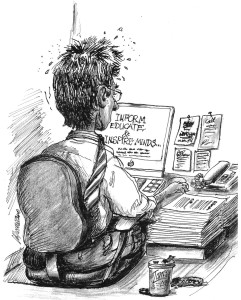|
King Weekly Sentinel https://kingsentinel.com/?p=3562 Export date: Thu Nov 28 16:47:43 2024 / +0000 GMT |
It’s vital for parents to read food labelsMark Pavilons 1  Know what you're putting in your body. That may seem like common sense, but how often do we read the labels of each and every packaged product we buy? Ontario has introduced legislation that requires calories now be posted on menus. This, the government contends, will make it easier for families to make informed and healthy food choices when eating out. The Making Healthier Choices Act, if passed, would make Ontario the first province to require food service premises to post calories on menus. The proposed legislation was developed following consultations with the food industry, health sector and parents. Specific measures in the legislation include: • Requiring calories for food and beverages, including alcohol, to be posted on menus and menu boards in restaurants, convenience stores, grocery stores and other food service premises with 20 or more locations in Ontario. • Requiring food service operators to post a contextual statement that would help to educate patrons about their daily caloric requirements. • Authorizing public health inspectors to enforce menu labelling requirements. This initiative builds on other steps Ontario is taking to help families live healthier, including the Healthy Kids Community Challenge – a province-wide initiative encouraging community leaders along with private and public sector partners to come together and develop initiatives to help kids stay healthy and active. Making it easier for Ontario families to choose healthy foods is a key component of the Healthy Kids Strategy and supports Ontario's Action Plan for Health Care. According to the government, up to 60 per cent of large chain restaurants with more than 20 locations in Ontario already provide nutritional information voluntarily to their customers (upon demand, on websites or in store). Approximately 95 per cent of Ontarians support requiring fast food restaurants to list nutrition information on their menus. Canada has had food labelling regulations for more than 20 years. While informing people of fat and calories may help them be more aware, allergy information on labels can save someone's life. In recent years, labels have contained vitally important allergy information. As a parent of a child with a life-threatening peanut allergy, such information is not only a bonus, it's vital. We often call restaurants, or visit their websites, to obtain allergy and nutritional information. Fortunately, more and more places are posting this information. It can be an ordeal when we go out as a family. We have to check, double check, and often ask to speak to a manager to ensure what we serve our child is safe. When first diagnosed with the allergy, we had to undertake a total household cleanse, removing any and all products that contained peanuts or even “may contain.” You'd be surprised just how many items that involves. Most dessert products “may contain” such as cereals, breads, chocolate bars, cookies, ice cream, pastries and the like. Would you think there are nuts in baby wipes, shampoo or lip balm? Did you know that shea butter is derived from a tree nut? People with tree nut allergies tend to suffer from them for their entire life. It's estimated that 91% of children allergic to tree nuts never overcome their allergy. Besides digestive problems, allergic reactions include asthma, hives, atopic dermatitis and anaphylactic shock. Among the wide variety of tree nuts, the most common offenders include cashews, walnuts and almonds. Because people are rarely allergic to just one kind of tree nut, it's advised that you just steer clear of all of them. A person may experience an allergic reaction to tree nuts even if they don't ingest them. Merely touching or using a topical product that contains them can be dangerous. Kyleigh used a soap at school one day that contained shea butter and her hands were like balloons when we picked her up. We've had to rid our place of certain dog foods, soaps, sunscreens and bird seed. Pet food doesn't fall under the same regulations, so it's really important to check those out. At first, our youngest child felt sad and scared about her allergy. She has to always carry an EpiPen and has been taught how to use it. We have to make sure whenever she's in a strange environment for the first time, that others know about her allergy and know about her EpiPen. We have to ask every household she enters whether they have nuts, or have eaten nuts recently. Kim accompanies her to most every birthday party, picnic or social gathering to keep a watchful eye over our precious cargo. Soon, more bar codes will allow those of us with a smart phone to scan the item and get all of this information immediately. Schools can be dangerous places for kids with allergies. Even though most schools today are nut-free, they can always find their way into kids' lunches. Some parents just don't get it. I praise the government for insisting that food labels contain all the correct information. While cutting back on calories is one thing, making sure every potential allergen is accounted for a must. |
Links:
|
|
Post date: 2014-03-04 11:31:19 Post date GMT: 2014-03-04 16:31:19 Post modified date: 2014-03-04 11:31:19 Post modified date GMT: 2014-03-04 16:31:19 |
|
Export date: Thu Nov 28 16:47:43 2024 / +0000 GMT This page was exported from King Weekly Sentinel [ https://kingsentinel.com ] Export of Post and Page has been powered by [ Universal Post Manager ] plugin from www.ProfProjects.com |